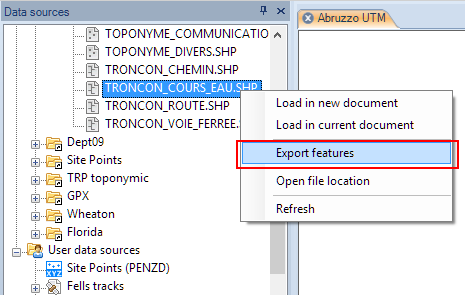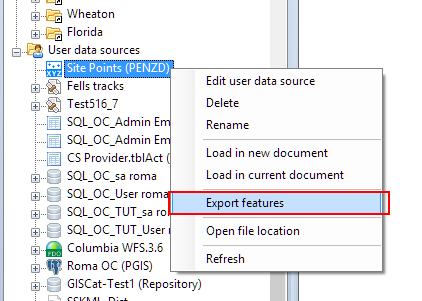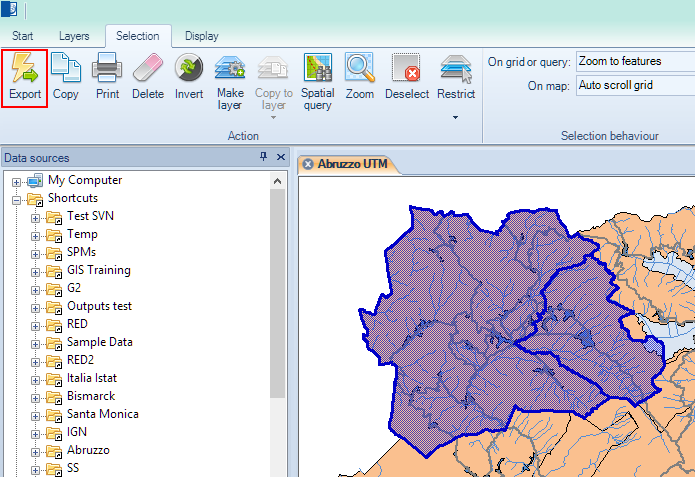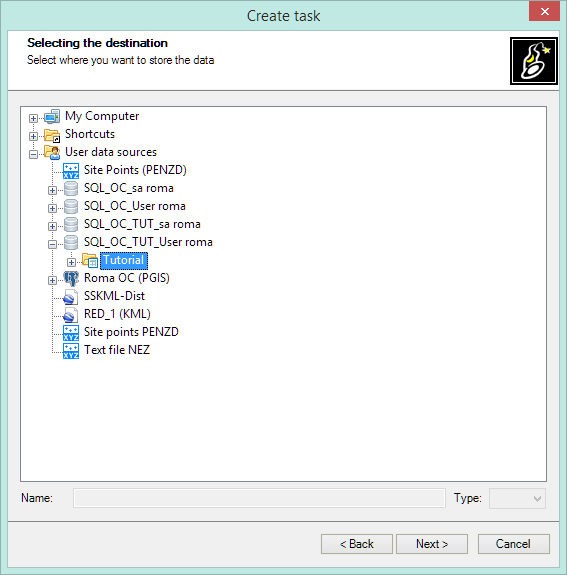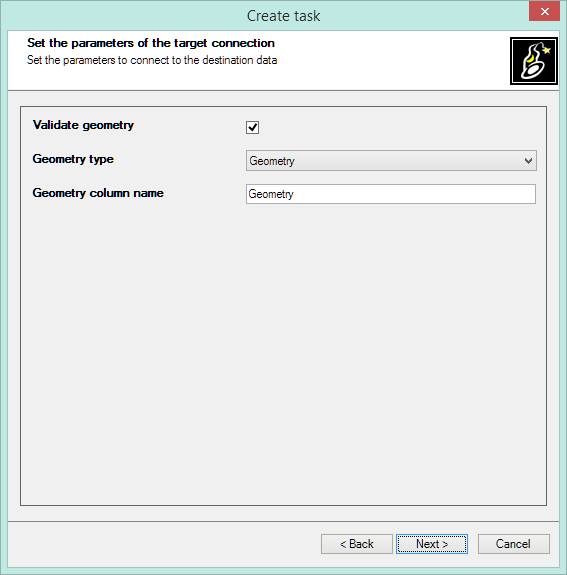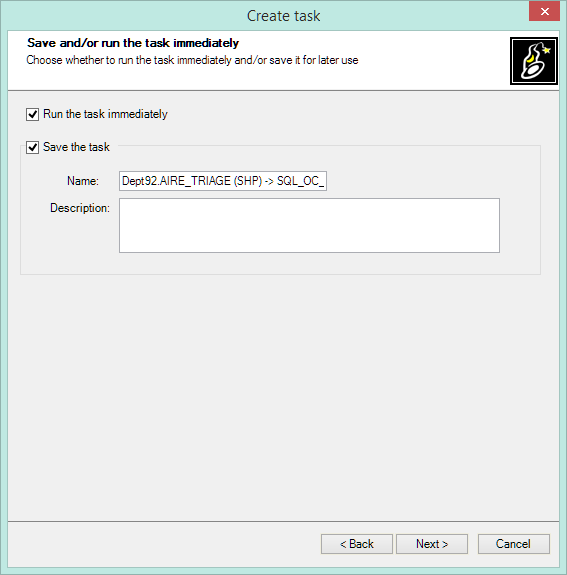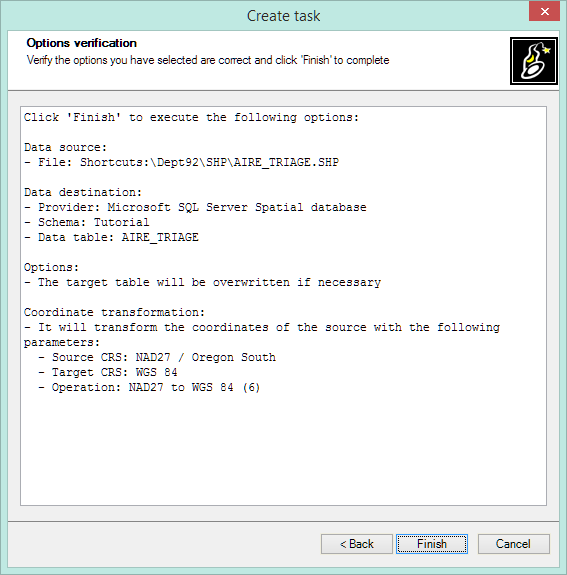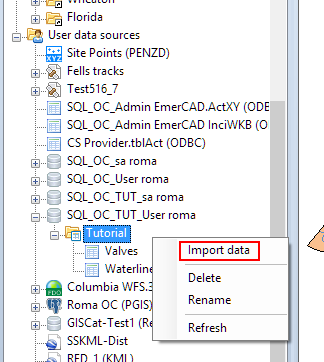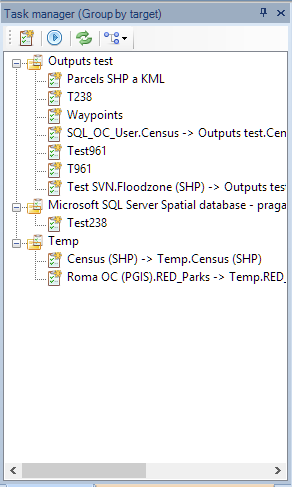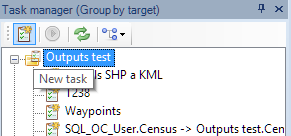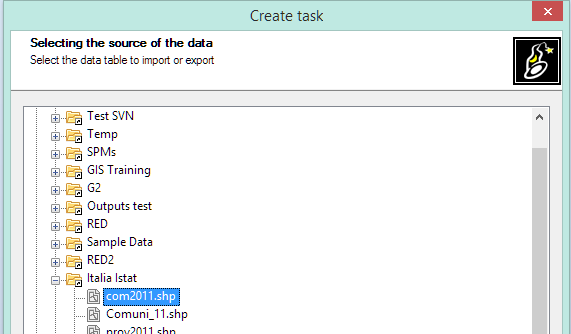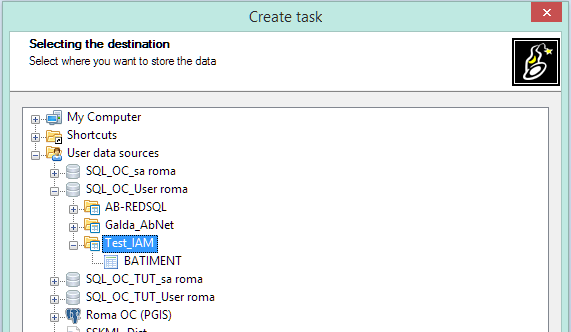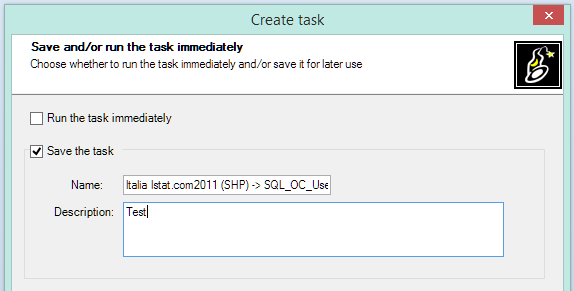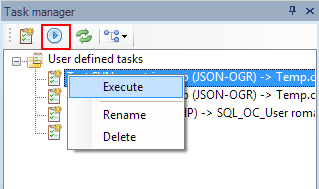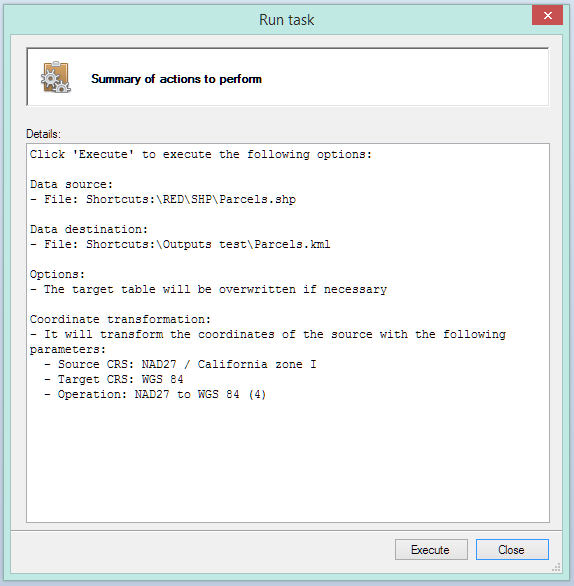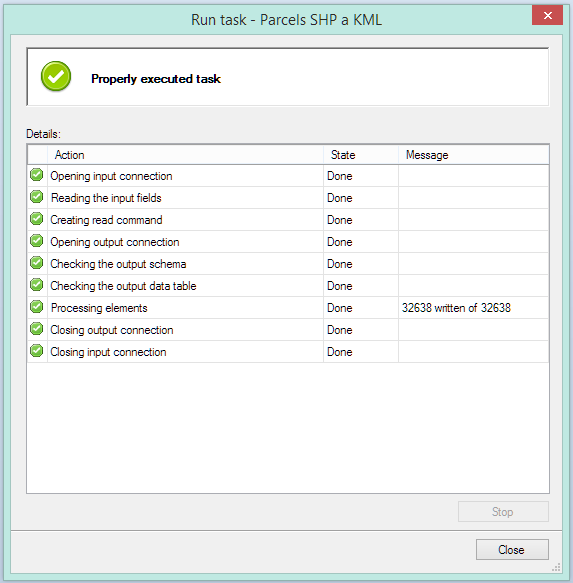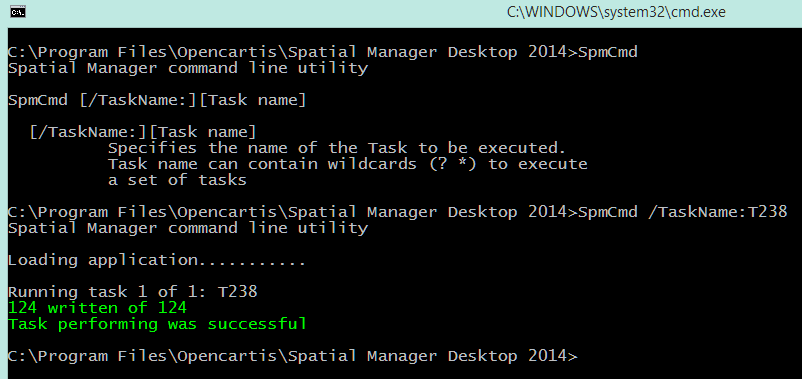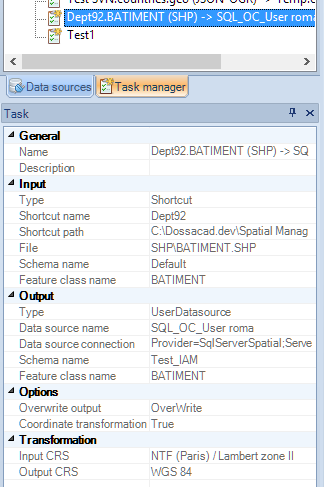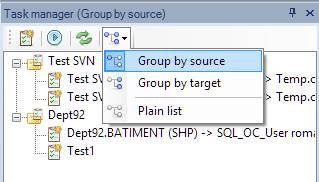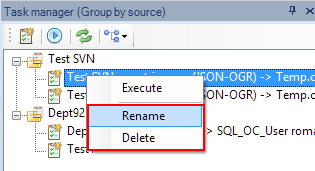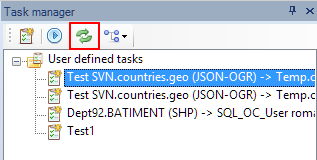Difference between revisions of "Spatial Manager Desktop™ - FAQs: Import and export"
| Line 162: | Line 162: | ||
| − | === <span id=" | + | === <span id="HowcanIdefineaTransformationofcoordinates">How can I define a Transformation of coordinates?=== |
When you are Importing/Exporting Features or creating a Task in Spatial Manager Desktop™, you will see that you can choose a Transformation of coordinates from the source to the target, in the corresponding wizard. That means that the application will calculate a geometric transformation between the source and the target data, which will depend on the chosen CRS for the source and for the target data. You can choose the appropriate CRSs by clicking on "CRS catalog...", in the CRS dropdown list for the source or for the target data. In the CRS table you can: | When you are Importing/Exporting Features or creating a Task in Spatial Manager Desktop™, you will see that you can choose a Transformation of coordinates from the source to the target, in the corresponding wizard. That means that the application will calculate a geometric transformation between the source and the target data, which will depend on the chosen CRS for the source and for the target data. You can choose the appropriate CRSs by clicking on "CRS catalog...", in the CRS dropdown list for the source or for the target data. In the CRS table you can: | ||
*Filter the CRSs by type (Geocentric, Projected, etc.) | *Filter the CRSs by type (Geocentric, Projected, etc.) | ||
Revision as of 15:23, 21 May 2014
Introduction
- Objective of this section
- To learn how to define import and export processes and their parameters, manage coordinate transformations and create and manage tasks
- Topics in this section
- Sources and targets: Layers, features Selection and data sources
- Data Providers parameters: connection and set up
- Transforming the coordinates: source and target, favorite coordinate systems, searching in the coordinate systems table and transformation parameters
- Creating and executing tasks: using the task manager panel, creating new tasks and executing saved tasks
- Task management: task tree organization, task properties, execution of tasks on the operating system Command window and batch processes
How can I export Features?
There are several ways to export Features and their associated data in Spatial Manager Desktop™
- Export a full Table: by right-clicking on the Table itself in the "Data sources" panel (drive/folder, Shortcut or UDS)
- Export a Layer in a Map: by selecting the Layer and using the function "Export features" in the "Layers" ribbon
- Export a Selection of Features in a Map: by selecting the Features in the Map and using the function "Export" in the "Selection\Tools" ribbon
In all cases the "Export" wizard will be launched to guide you through the steps necessary to export a set of Features:
- Set up the Parameters of the source connection (if any), which will depend on the data Provider of the source connection
- Choose the target for the exporting process (this step will also define the target data Provider). You have to choose:
- A folder, or a Shortcut to a folder. In this case, you must also choose the type of target file by expanding the dropdown list of valid extensions to Export
- A container for Tables (usually a Schema)
- A file to replace (directly or through a UDS)
- A Table to replace (inside a container of Tables; usually a Schema)
- Set up the Parameters of the target connection (if any), which will depend on the data Provider of the target connection
- Choose the Options offered by the target connection data Provider, such as Overwrite the target or Transform the coordinates
- Choose if you want to Run now and/or to Save a Task (except when exporting a Layer or when exporting a Features Selection)
The wizard lets you go backwards or forwards to modify the entries at every step
Note: if the source or the target connection comes from a UDS, some Parameters may be "caught" from the UDS itself (depends on the data Provider of the UDS) and you will not need to reenter them
How can I Import Features?
You can Import Features in Spatial Manager Desktop™ by right-clicking on a container (usually a Schema) of Tables in the "Data sources" panel. The Import process is similar to any Export process but, in this case, the target for the process is known and you have to first choose the source data to import
What are the Tasks?
The Tasks in Spatial Manager Desktop™ are the way you can save any import/export process and its parameters, that have been designed to let you run, whenever you want, repetitive processes for import or export data tables. You can execute any Task directly from the application or from the operating system command window (this feature also lets you define powerful batch processes). You can access Tasks through the "Task manager" panel
The processes of extraction of the tables from the servers must be executed on a regular basis and sometimes these processes require the introduction of several more or less complex parameters, such as the destination file type, its location and its own parameters, perform a coordinate transformation between the origin and target, etc. Spatial Manager Desktop™ brings to you the concept of “Task”, that allows you to store all needed operations and parameters for any import or export process of spatial information. Once all necessary operations and parameters are saved as a Task, you can then run it from the Task Manager whenever you need. In addition, the application also allows you to run these Tasks from the operating system Command window and use wildcard characters for the name of the Tasks to be executed. This feature will allow you to program simple but powerful batch processes for the execution of multiple Tasks
How can I create a new Task?
You can create new Tasks in Spatial Manager Desktop™ using the "New task" button, in the "Task manager" panel, to start the "Create task" wizard, but you can also create new Tasks when you are defining any import/export process (except when exporting a Layer or when exporting a Features Selection) because you will then run the same application wizard
When you create a new Task, you will need to enter all the parameters to access origin and target data tables, the coordinate system transformation parameters (optional), the name of the Task and a description of the Task (optional). All this data is saved, into the "Task manager", as a new Task, until you want to delete it. Note that if you want to use a read-only UDS, you will be able to read data through this UDS (valid as origin) but not to write data (not valid as target)
How can I execute a Task?
You have two ways of executing Tasks in Spatial Manager Desktop™
The first way, directly in the application. To execute the selected Task, use the right-click menu over the Task name itself and click on "Execute", use the "Execute" button or double-click on the Task name, in the "Task manager" panel. This will start "Run start" where you will firstly see all the data of the Task and, if you want to, execute it
When executing the Task you will see a window showing all the actions performed by the Task and, if you want to, you can cancel it before the end
The second way, through the operating system command window. You have to open a command window in the folder where the program is installed, execute the command "SpmCmd", its parameter "/TaskName:", and the name of the Task to execute, where you can use wildcards such as "*" to execute several Tasks from one only command. Every time a Task has been executed, you will get a resume line showing the number of Features exported, if the Task performing was successful, or any error message that could be produced in the process
Can I see the Properties of a Task?
Yes, you can see the Properties of the selected Task in the "Properties" panel in Spatial Manager Desktop™
Can I sort the Tasks in the "Task manager" panel?
You cannot change the relative positions of the Tasks in the "Task manager" panel, but you can sort the Tasks in Spatial Manager Desktop™ by selecting the "Sort" button in this panel as follows:
- Group by source: you will see the Tasks grouped by their source data source
- Group by target: you will see the Tasks grouped by their target data source
- Plain list: you will see a list of all Tasks sorted by date of creation
Are there any other functions for the Tasks?
Yes, you can Delete and Rename the Tasks in Spatial Manager Desktop™ using the right-click menu over the Task item, in the "Task manager" panel. You can also "Refresh" the Task list, using the "Refresh" button in the "Task manager" panel, if you make changes to your data sources in the current work session
How can I define a Transformation of coordinates?
When you are Importing/Exporting Features or creating a Task in Spatial Manager Desktop™, you will see that you can choose a Transformation of coordinates from the source to the target, in the corresponding wizard. That means that the application will calculate a geometric transformation between the source and the target data, which will depend on the chosen CRS for the source and for the target data. You can choose the appropriate CRSs by clicking on "CRS catalog...", in the CRS dropdown list for the source or for the target data. In the CRS table you can:
- Filter the CRSs by type (Geocentric, Projected, etc.)
- Choose a CRS by clicking on its row in the table
- Search CRSs by typing the search criteria on the "Search" box. You can type here as many words as you like separated by blanks. The application will find all the rows including all these words in a column of the table
After choosing a pair of valid CRS for a Transformation, you must choose the geographic Area to apply it to (the application will choose by default the most common Area for this Transformation)
Note 1: as you will see, the CRS dropdown list will include more and more CRSs as they have been previously chosen in others Transformation operations, so that you can choose your "favorite" CRSs directly from the dropdown list without having to access the CRS Table all the time
Note 2: if the application "knows" the CRS of the source or of the target data, they will be chosen by default. You will be able to modify this choice except in cases where only one CRS is valid; for example, for a KML or a KMZ file the only valid choice is the CRS WGS84 (SRID 4326), because these types of file are always defined using this CRS
Note 3: if you have chosen the same CRS for the source and the target data, the application does not perform any geometric transformation of the Features, and warns you about it, but the resulting target data includes this CRS as the geo-referencing information of the Table
Related links
- See "Providers" also
- Converting SHP to KML
- How to geo-reference an 'unreferenced' spatial Table?
- Import directly to PostGIS databases
- Convert OpenStreetMap data to Shapefiles (SHP)
